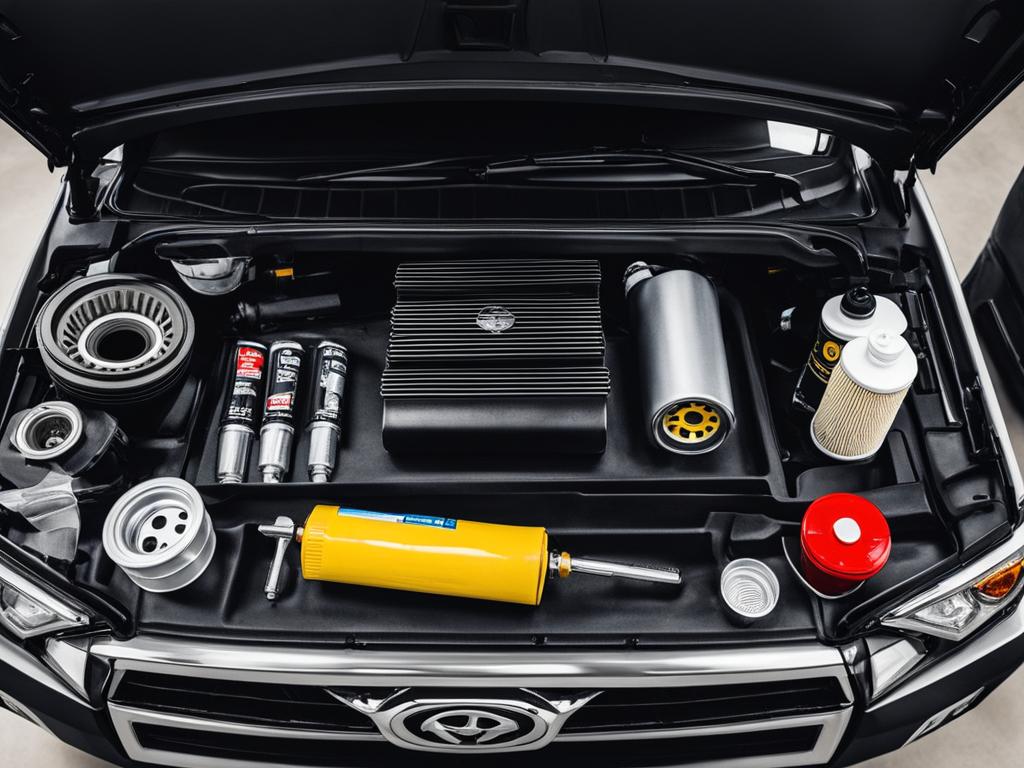4Runner Oil Change Guide – Quick & Easy Tips
Changing the oil in your Toyota 4Runner is an essential part of its maintenance routine. Regular oil changes not only ensure optimal performance but also extend the lifespan of your vehicle’s engine. In this comprehensive guide, we will provide you with step-by-step instructions on how to perform an oil change on your 4Runner, as well as offer valuable tips and recommendations for a smooth and hassle-free process.
Key Takeaways:
- Regular oil changes are crucial for maintaining the health and performance of your Toyota 4Runner.
- Consult your owner’s manual for the specific oil change interval recommended by Toyota.
- Gather all the necessary supplies, including the correct type of oil and a Toyota filter kit, before starting the oil change process.
- Take safety precautions and dispose of the used oil responsibly to protect yourself and the environment.
- Don’t forget to reset the maintenance indicator after completing the oil change to ensure accurate upkeep records.
Supplies Needed for an Oil Change
Before starting the oil change process, gather the necessary supplies. Make sure you have everything you need to ensure a smooth and efficient oil change for your Toyota 4Runner.
- 7 quarts of synthetic 0W-20 oil: Obtaining high-quality oil is essential for the optimal performance of your 4Runner’s engine. We recommend using Mobil1 or Toyota Oil to ensure superior lubrication and protection.
- Toyota filter kit: You will need a Toyota filter kit that includes the part number 04152-YZZA5. This kit ensures a proper fit for your 4Runner, providing effective filtration and maintaining the cleanliness of your engine oil.
- Drain pan: A drain pan is necessary to catch the old oil as it is removed from your 4Runner’s engine. It helps prevent oil spills and keeps your workspace clean and organized.
- Funnel: Using a funnel makes pouring the new oil into your 4Runner’s oil filler neck easier and minimizes the risk of spills or overfilling.
- 64mm filter wrench: This filter wrench is specifically designed to fit the oil filter housing on your 4Runner. It allows for easy removal and installation of the oil filter, ensuring a secure and leak-free seal.
- 3/8″ drive ratchet with extensions and 10mm, 12mm, and 14mm sockets: These tools are necessary for removing the oil drain plug and other components during the oil change process. Make sure you have the correct socket sizes to fit your 4Runner’s specific fasteners.
- Nitrile gloves, old microfiber towels, and papertowels: Keeping your hands clean and your workspace tidy is important during an oil change. Nitrile gloves provide protection while working with oil, and old microfiber towels and papertowels come in handy for wiping up spills and cleaning surfaces.
Before proceeding with the oil change, it is always a good idea to consult your owner’s manual for any specific instructions or guidelines related to your particular model and year of the 4Runner.
If you have gathered all these supplies, you are well-prepared to tackle the oil change process and keep your 4Runner running smoothly for miles to come!
Preparing for the Oil Change
Before diving into the oil change process, there are a few steps to take to prepare your 4Runner. Start by driving your vehicle to warm up the engine and ensure the oil is at operating temperature. This will make the oil flow more efficiently during the change.
Once back in your garage, put on your old clothes, connect your smartphone to the stereo, and crank up your favorite tunes. It’s time to get dirty and have some fun!

Now that you’re mentally and physically prepared, let’s dive into the oil change process.
Draining the Old Oil
With your 4Runner prepped and ready, it’s time to drain the old oil. Follow the step-by-step instructions below to safely and efficiently remove the old oil from your vehicle:
- Locate the oil drain cover: Use a 12mm socket to remove the bolts securing the oil drain cover.
- Find the oil drain plug: Underneath the oil drain cover, you’ll find the 14mm oil drain plug.
- Position the drain pan: Place a drain pan beneath the oil drain plug to catch the old oil.
- Remove the oil drain plug: Carefully and slowly remove the oil drain plug by hand, being prepared for the hot oil to gush out.
- Inspect the drain plug: Take note of the condition of the drain plug, including the washer. The washer should be replaced each time you change the oil.
Now you’ve successfully drained the old oil from your 4Runner. Next, we’ll move on to removing the oil filter and housing.
Removing the Filter and Housing
After draining the oil, the next step in the oil change process for your Toyota 4Runner is to remove the oil filter and housing. Follow the steps below to complete this task.
Gather Necessary Tools and Supplies
Before starting, make sure you have the following tools and supplies:
- 64mm filter wrench
- Drain pan
- Old microfiber towels
- Paper towels
Access the Filter Housing
To access the filter housing, you’ll first need to remove the skid plate and plastic cover. These components may be secured by bolts or clips, so refer to your vehicle’s manual for specific instructions. Once removed, you’ll have a clear view of the filter housing.
Remove the Filter Housing
Using the 64mm filter wrench, carefully loosen and remove the filter housing. Be cautious as it may be tightly secured. Place the filter housing in a safe location, as you will need to reinstall it later.
Replace the Filter and O-Ring
With the filter housing removed, you can now replace the old oil filter and O-ring. Start by removing the old filter from the housing, ensuring that all debris and residue are cleaned from the housing and grooves. Discard the old filter and O-ring properly.
Note: When handling the new filter and O-ring, make sure your hands are clean to avoid introducing any contaminants.
Install the new O-ring to the filter housing, ensuring it is properly seated. Next, insert the new filter into the housing, aligning it correctly. Double-check that both the O-ring and filter are securely in place.
Reinstall the Filter Housing
Now that the new filter and O-ring are in place, it’s time to reinstall the filter housing. Align the housing with the mounting location on the engine and hand-tighten it until it is snug. Avoid over-tightening as it may lead to damage.
Clean Up
Before moving on to the next step, take a moment to clean up any excess oil or debris that may have spilled during the process. Properly dispose of any used materials, such as the old filter and paper towels.
By following these steps, you have successfully removed and replaced the oil filter and housing in your Toyota 4Runner. The next section will guide you through the process of installing the new filter and housing, ensuring proper functionality and performance.
Installing the New Filter and Housing
With the old filter and housing removed, it’s time to install the new components. Follow these steps to ensure a proper installation:
- Clean the inside of the filter housing and the metal housing on the engine to remove any dirt, debris, or old oil residue.
- Coat the new O-ring with fresh oil to create a proper seal. This helps prevent leaks and ensures a tight fit.
- Install the O-ring onto the plastic housing, making sure it is seated securely.
- Next, insert the new filter into the housing, aligning it with the grooves and ensuring a snug fit.
- Reinstall the housing onto the engine, lining up the bolt holes with the mounting points.
- Tighten the housing bolts until the metal indicator tab is back in its original location. Be careful not to overtighten.
- Double-check your work to ensure everything is clean and leak-free before proceeding.
By performing these steps carefully, you can ensure that the new filter and housing are installed correctly, promoting optimal performance and oil filtration for your 4Runner.
Recommended Oil Filter Replacement Schedule
Regularly replacing the oil filter is essential to maintain the efficiency and longevity of your 4Runner’s engine. Refer to the table below for the recommended oil filter replacement schedule:
| Mileage | Time Interval |
|---|---|
| 5,000 miles | 6 months |
| 10,000 miles | 12 months |
| 15,000 miles | 18 months |
| 20,000 miles | 24 months |
Following this schedule ensures that your 4Runner’s engine is protected from contaminants and operates at its peak performance.

Refilling with Fresh Oil
Once you have successfully installed the filter and housing, it’s time to replenish your Toyota 4Runner with fresh oil. This step is crucial for maintaining the health and performance of your engine.
To begin, you will need to pour in 6.6 quarts of synthetic 0W-20 oil. It is essential to use the correct oil type and quantity recommended by the manufacturer for optimal performance. Be careful not to overfill the engine, as this can lead to potential issues.
After adding the oil, start the engine and let it run for a few minutes. This allows the oil to circulate throughout the engine and ensures proper lubrication. While the engine is running, check for any signs of leaks and inspect the oil level using the dipstick.
Using the dipstick, carefully remove it from the engine, wipe it clean with a cloth, and reinsert it fully. Once again, remove the dipstick and check the oil level. It should fall between the indicator dots on the dipstick, indicating the correct oil level. If necessary, adjust the oil level by adding or draining oil accordingly.
Remember, maintaining the proper oil level is crucial for the longevity and performance of your 4Runner.
Dispose of the old oil responsibly by taking it to a recycling center or an auto parts store that accepts used oil. It is important to handle used oil with care and avoid any spills or mess. Clean up any oil spills promptly using absorbent materials such as cat litter or sand.
Resetting the Maintenance Indicator
After completing the oil change, it’s important to reset the maintenance indicator on your 4Runner. This ensures that you’ll receive accurate notifications for your next scheduled maintenance.
To reset the maintenance indicator, follow these steps:
- Refer to your owner’s manual for the specific procedure, as it may vary depending on the year and model of your vehicle.
- Typically, the process involves turning the key to the ON position without starting the engine.
- Press and hold the trip meter reset button.
- Turn the key to the OFF position while still holding the trip meter reset button.
Make sure to follow the instructions carefully to ensure the indicator is reset successfully. By resetting the maintenance indicator, you’ll be able to keep track of the next oil change and other important maintenance tasks for your 4Runner.

| Make | Model | Year | Maintenance Indicator Reset Procedure |
|---|---|---|---|
| Toyota | 4Runner | 2016-2021 | Turn the key to the ON position without starting the engine. Press and hold the trip meter reset button. Turn the key to the OFF position while still holding the trip meter reset button. |
| Toyota | 4Runner | 2010-2015 | Turn the key to the ON position without starting the engine. Press and hold the trip meter reset button. Turn the key to the OFF position while still holding the trip meter reset button. |
| Toyota | 4Runner | 2003-2009 | Turn the key to the ON position without starting the engine. Press and hold the trip meter or ODO reset button. Turn the key to the OFF position while still holding the trip meter or ODO reset button. |
Safety and Environmental Considerations
When performing an oil change, it’s crucial to prioritize safety and environmental responsibility. Always use proper jack stands or ramps to lift your vehicle and ensure it is secure before going underneath. Use gloves and other protective gear to avoid any injuries. Additionally, dispose of the old oil properly by taking it to a recycling center or an auto parts store that accepts used oil. Avoid dumping or improper disposal that can harm the environment.
Safe Lifting Techniques
Before starting an oil change, make sure you have the necessary equipment to safely lift your 4Runner. Use jack stands or ramps to support the vehicle and prevent accidents. Ensure that the vehicle is on a level surface and engage the parking brake.
“Properly securing your vehicle before crawling underneath is crucial for your safety. Jack stands or ramps provide stability and minimize the risk of accidents.”
Familiarize yourself with the manufacturer’s instructions for raising and lowering the vehicle. Always follow the recommended lifting points specified in the owner’s manual to avoid damage to your 4Runner.
Protective Gear
Protective gear is essential when performing an oil change. Gloves will protect your hands from oil and other fluids, preventing skin irritation or contamination. Additionally, wearing old clothes is recommended to avoid staining or soiling your regular attire. Don’t forget to keep a rag or paper towels handy for any spills or drips.
Proper Oil Disposal
Oil disposal plays a vital role in environmental protection. Used oil contains contaminants that can harm ecosystems if not disposed of correctly. To dispose of your old oil properly, follow these steps:
- Allow the used oil to cool completely before handling.
- Transfer the old oil to a leak-proof container, such as a dedicated oil drain pan or a tightly sealed plastic container.
- Seal the container tightly to prevent spills or leaks during transportation.
- Take the container to a certified recycling center or an auto parts store that accepts used oil. Find the nearest recycling center by searching “4Runner oil change near me”.
- Never dispose of used oil in household drains, storm drains, or the trash.
Environmental Impact
Proper oil disposal is not only a legal responsibility but also an ethical one. By disposing of used oil appropriately, you contribute to the preservation of the environment. Incorrect disposal can contaminate water sources, harm wildlife, and damage ecosystems.
“Safely disposing of used oil ensures a clean and healthy environment for future generations.
By adopting responsible practices, such as recycling used oil, you are actively contributing to the protection of our planet.

| Disposal Method | Advantages | Disadvantages |
|---|---|---|
| Recycling Center | Proper handling and recycling of used oil | Requires transportation to the recycling facility |
| Auto Parts Store | Convenient disposal option | Limited to certain store locations |
| Household Drain | Easy disposal at home | Pollutes water sources and harms the environment |
| Trash | Immediate disposal | Potential leaks, contamination, and harm to wildlife |
Regular Oil Change Maintenance
Regular oil changes are essential for maintaining the longevity and performance of your Toyota 4Runner. By following a regular maintenance schedule, you can keep your engine running smoothly and prevent potential damage in the long run. Toyota recommends changing the oil in your 4Runner every 10,000 miles or according to the guidelines provided in your owner’s manual.
By adhering to this recommended oil change interval, you ensure that your engine receives fresh, clean oil on a regular basis. Fresh oil helps lubricate the engine’s moving parts, reducing friction and heat buildup. This allows the engine to operate optimally and efficiently, minimizing the risk of wear and tear.
In addition to keeping the engine in good condition, regular oil changes offer an opportunity for inspections. During each oil change, take the time to thoroughly inspect your vehicle for any potential issues. This includes checking for leaks, unusual noises, and any other signs of mechanical problems.
By catching these problems early on, you can address them promptly, preventing them from developing into major and costly repairs. Routine inspections also give you peace of mind, knowing that your 4Runner is in good working condition.
Benefits of Regular Oil Changes:
- Improved engine performance and efficiency
- Reduced risk of engine damage and wear
- Opportunity for regular inspections
- Prolonged engine life
Remember, regular oil changes are not only essential for the optimal performance of your 4Runner but also for maintaining its value and reliability over time. Don’t neglect this crucial aspect of vehicle maintenance and prioritize oil changes as part of your overall care routine.
In the next section, we will discuss the final steps to complete the oil change process and provide you with important tips to ensure a successful and hassle-free experience.

Conclusion
Changing the oil in your Toyota 4Runner is a crucial part of its maintenance routine. With the step-by-step instructions provided in this guide, you can easily perform an oil change at home. By using the right tools and supplies, you will be able to maintain your 4Runner’s engine health and ensure optimal performance.
It’s essential to follow the recommended oil change interval and dispose of the used oil responsibly. Regular oil changes will help prolong the lifespan of your 4Runner and prevent potential engine damage. With proper care and maintenance, your 4Runner will continue to serve you well for many years to come.
Remember, safety should always be a priority when performing any maintenance on your vehicle. Use jack stands or ramps to lift your 4Runner securely and wear protective gear to avoid injuries. Additionally, ensure proper disposal of the used oil by taking it to a recycling center or an auto parts store that accepts used oil.
FAQ
What supplies do I need for an oil change?
To perform an oil change on your Toyota 4Runner, you will need 7 quarts of synthetic 0W-20 oil, preferably Mobil1 or Toyota Oil. You will also require a Toyota filter kit, which includes the part number 04152-YZZA5. Other necessary tools include a drain pan, funnel, 64mm filter wrench, 3/8″ drive ratchet with extensions and 10mm, 12mm, and 14mm sockets. Nitrile gloves, old microfiber towels, and papertowels will help keep things clean. Consult your owner’s manual for any specific instructions or guidelines.
How do I prepare for an oil change on my 4Runner?
Before starting the oil change process, it is important to warm up the engine by driving your vehicle. This ensures that the oil is at operating temperature and will flow more efficiently during the change. Additionally, gather all the necessary tools and supplies, put on old clothes, and connect your smartphone to the stereo to enjoy some music while you work.
How do I drain the old oil from my 4Runner?
To drain the old oil, locate the oil drain cover and remove the bolts securing it using a 12mm socket. Underneath, you will find the 14mm oil drain plug. Position a drain pan beneath the plug, then carefully and slowly remove the plug by hand. Be prepared for the hot oil to gush out. Take note of the drain plug’s condition and the washer, which should be replaced each time.
How do I remove the oil filter and housing?
Start by removing the skid plate and plastic cover to access the filter housing. Then, use a 64mm filter wrench to loosen and remove the filter housing. Take caution as it may be tight. Remove the old filter from the housing, along with the old O-ring. Clean the housing and grooves thoroughly, ensuring no debris is left behind.
How do I install the new filter and housing?
After removing the old filter and housing, clean the inside of the filter housing and the metal housing on the engine. Coat the new O-ring with fresh oil and install it onto the plastic housing. Insert the new filter into the housing, making sure it is seated properly. Reinstall the housing onto the engine and tighten it until the metal indicator tab is back in its original location. Double-check your work and ensure everything is clean and leak-free.
How do I refill my 4Runner with fresh oil?
Pour in 6.6 quarts of synthetic 0W-20 oil into the engine, being careful not to overfill. Start the engine and let it run for a few minutes to allow the oil to circulate. Check for any leaks and inspect the oil level using the dipstick. Adjust the oil level as necessary, making sure it falls between the indicator dots on the dipstick. Dispose of the old oil responsibly and clean up any spills or mess.
How do I reset the maintenance indicator on my 4Runner?
Refer to your owner’s manual for the specific procedure to reset the maintenance indicator, as it may vary depending on the year and model of your vehicle. Typically, the process involves turning the key to the ON position without starting the engine, pressing and holding the trip meter reset button, and then turning the key to the OFF position. Follow the instructions carefully to ensure the indicator is reset successfully.
What safety and environmental considerations should I keep in mind during an oil change?
It is crucial to prioritize safety by using proper jack stands or ramps to lift your vehicle and ensure it is secure before going underneath. Wear gloves and other protective gear to avoid injuries. Additionally, dispose of the old oil properly by taking it to a recycling center or an auto parts store that accepts used oil. Avoid dumping or improper disposal that can harm the environment.
How often should I perform an oil change on my 4Runner?
Toyota recommends changing the oil every 10,000 miles or according to your owner’s manual. Following this maintenance schedule will help keep your engine running smoothly and prevent potential damage. Regular oil changes also allow for inspections of your vehicle, helping you identify any potential issues and address them before they become major problems.
Can I perform an oil change on my 4Runner at home?
Yes, an oil change on your Toyota 4Runner can be done at home with the right tools and supplies. By following the steps outlined in this guide and adhering to the recommended oil change interval, you can maintain your 4Runner’s engine health and performance. Remember to dispose of the used oil responsibly and follow all safety precautions.




